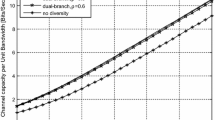Abstract
In this paper, we develop a framework to analyze the performance analysis of multi-antenna system that employ maximal-ratio transmission with receive antenna selection (MRT/RAS) over correlated Nakagami-m fading channels. We derive the probability density function (pdf) of the post processing signal-to-noise ratio at the output of the decoder, when spatial fading correlation is assumed. Utilizing the pdf, a closed-form analytical expression is derived in terms of channel capacity, outage probability and symbol error rate (SER) of M-ary modulation schemes. It can be observed that the performance loss in terms of capacity and SER is negligible when the separation between adjacent antennas is as large as 0.5 for exponential correlation model. Numerical outcomes considering the spatial correlation represent the performance characteristics and analyze their impacts on channel capacity, outage probability and SER of MRT/RAS system.




Similar content being viewed by others
References
Telatar, I. E. (1999). Capacity of multi-antenna Gaussian channels. European Transactions on Telecommunications,10, 585–595.
Foschini, G. J., & Gans, M. J. (1998). On limits of wireless communication in a fading environment when using multiple antennas. Wireless Personal Communications,6, 311–355.
Alamouti, S. M. (1998). A simple transmit diversity technique for wireless communication. IEEE Journal Selected Areas in Communications,16(8), 1451–1458.
Gore, D. A., & Paulraj, A. (2002). MIMO antenna subset selection with space-time coding. IEEE Transactions on Signal Processing,50(10), 2580–2588.
Molisch, A. F., Win, M. Z., Choi, Y. S., & Winters, J. H. (2005). Capacity of MIMO system with antenna selection. IEEE Transactions on Wireless Communications,4(4), 1759–1772.
Zeng, X. N., & Ghrayeb, A. (2004). Performance bounds for space-time block codes with receive antenna selection. IEEE Transactions on Information Theory,50, 2130–2137.
Chen, Z., Yuan, J., & Vucetic, B. (2005). Analysis of transmit antenna selection/maximal-ratio combining in Rayleigh fading channels. IEEE Transactions on Vehicular Technology,54(4), 1312–1321.
Chen, Z., Chi, Z., Li, Y., & Vucetic, B. (2009). Error performance of maximal-ratio combining with transmit antenna selection in flat Nakagami-m fading channels. IEEE Transactions on Wireless Communications,8(1), 424–431.
Wang, B. Y., & Zheng, W. X. (2009). BER performance of transmitter antenna selection/receiver-MRC over arbitrarily correlated fading channels. IEEE Transactions on Vehicular Technology,58(6), 3088–3092.
Ramya, T. R., & Bhashyam, S. (2009). Using delayed feedback for antenna selection in MIMO systems. IEEE Transactions on Wireless Communications,8(12), 6059–6067.
Rui, X. (2012). Analysis of MIMO MRT/SC system. Wireless Personal Communications,62(1), 117–126.
Coskun, A. F., & Kucur, O. (2012). Performance analysis maximal-ratio transmission/receive antenna selection in Nakagami-m fading channels with channel estimation errors and feedback delay. IEEE Transactions on Vehicular Technology,61(3), 1099–1108.
Luo, L., Zeidler, J. R., & McLaughlin, S. (2001). Performance analysis of compact antenna arrays with MRC in correlated Nakagami fading channels. IEEE Transactions on Vehicular Technology,50(1), 267–277.
Chauhan, S. S., & Kumar, S. (2014). Capacity analysis of adaptive transmission with space-time block codes in spatially correlated MIMO Nakagami-m fading channels. Wireless Personal Communication,79(2), 1211–1222.
Proakis, J. G. (2000). Digital communication (4th ed.). New York: McGraw-Hill.
David, H. A. (1970). Order statistics. New York: Wiley.
Alouini, M. S., & Goldsmith, A. J. (1999). Capacity of Rayleigh Fading channels under different adaptive transmission and diversity combining technique. IEEE Transactions on Vehicular Technology,48(4), 1165–1181.
Simon, M. K., & Alouini, M. S. (2000). Digital communication over fading channels: A unified approach to performance analysis. New York: Wiley.
Gradshteyn, I. S., & Ryzhik, I. M. (2000). Table of integrals, series, and products (6th ed.). San Diego, CA: Academic.
Cho, K., & Yoon, D. (2002). On the general BER expression of one-and two-dimensional amplitude modulations. IEEE Transactions on Communications,50, 1074–1080.
Lu, J., Letaief, K. B., Chuang, J. C. I., et al. (1999). M-PSK and M-QAM BER computation using signal-space concepts. IEEE Transactions on Communications,47(2), 181–184.
Loskot, P., & Beaulieu, N. C. (2009). Prony and polynomial approximations for evaluation of the average probability of error over slow-fading channels. IEEE Transactions on Vehicular Technology,58(3), 1269–1280.
Lombardo, P., Fedele, G., & Rao, M. M. (1999). MRC performance for binary signals in Nakagami fading with general branch correlation. IEEE Transactions on Communications,47(1), 44–52.
Author information
Authors and Affiliations
Corresponding author
Additional information
Publisher's Note
Springer Nature remains neutral with regard to jurisdictional claims in published maps and institutional affiliations.
Appendices
Appendix 1
Inserting (12) into (31), the upper bound capacity can be written as
By utilizing the identity [19] \( \int_{0}^{\infty } {x^{v - 1} } e^{ - \mu x} dx = \mu^{ - v} \Gamma \left( v \right) \), the upper bound capacity can be obtained in (19).
Appendix 2
Inserting (12) and (28) into (24)
Utilizing the identity [19] \( \int_{0}^{\infty } {x^{v - 1} } e^{ - \mu x} dx = \frac{1}{{\mu^{v} }}\Gamma \left( v \right) \), we can achieve approximate closed-form expression of average SER of MRT/RAS with MPSK in (29).
Rights and permissions
About this article
Cite this article
Chauhan, S.S., Kumar, S. Performance analysis of maximal ratio transmission with receiver antenna selection over correlated Nakagami-m fading channels. Wireless Netw 26, 751–758 (2020). https://doi.org/10.1007/s11276-019-02179-0
Published:
Issue Date:
DOI: https://doi.org/10.1007/s11276-019-02179-0




